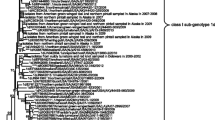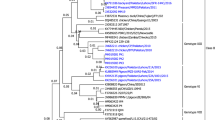Abstract
Avian paramyxovirus serotype 1 (APMV-1), or Newcastle disease virus, is the causative agent of Newcastle disease, one of the most economically important diseases for poultry production worldwide and a cause of periodic epizootics in wild birds in North America. In this study, we examined the genetic diversity of APMV-1 isolated from migratory birds sampled in Alaska, Japan, and Russia and assessed the evidence for intercontinental virus spread using phylogenetic methods. Additionally, we predicted viral virulence using deduced amino acid residues for the fusion protein cleavage site and estimated mutation rates for the fusion gene of class I and class II migratory bird isolates. All 73 isolates sequenced as part of this study were most closely related to virus genotypes previously reported for wild birds; however, five class II genotype I isolates formed a monophyletic clade exhibiting previously unreported genetic diversity, which met criteria for the designation of a new sub-genotype. Phylogenetic analysis of wild-bird isolates provided evidence for intercontinental virus spread, specifically viral lineages of APMV-1 class II genotype I sub-genotypes Ib and Ic. This result supports migratory bird movement as a possible mechanism for the redistribution of APMV-1. None of the predicted deduced amino acid motifs for the fusion protein cleavage site of APMV-1 strains isolated from migratory birds in Alaska, Japan, and Russia were consistent with those of previously identified virulent viruses. These data therefore provide no support for these strains contributing to the emergence of avian pathogens. The estimated mutation rates for fusion genes of class I and class II wild-bird isolates were faster than those reported previously for non-virulent APMV-1 strains. Collectively, these findings provide new insight into the diversity, spread, and evolution of APMV-1 in wild birds.



Similar content being viewed by others
References
Lamb RA, Parks GD (2007) Paramyxoviridae: the viruses and their replication. In: Knipe DM, Howley PM, Griffin DE, Lamb RA, Martin MA, Roizman B, Straus SE (eds) Field’s virology, 5th edn. Lippincott Williams & Wilkins, Philadelphia, pp 1449–1496
Alexander DJ, Senne DA (2008) Newcastle disease, other avian paramyxoviruses, and pneumovirus infections. In: Saif YM, Fadly AM, Glisson JR, McDougald LR, Nolan LK, Swayne DE (eds) Diseases of poultry, 12th edn. Iowa State University Press, Ames, pp 75–100
Wobeser G, Leighton FA, Norman R, Myers DJ, Onderka D, Pybus MJ, Neufeld JL, Fox GA, Alexander DJ (1993) Newcastle disease in wild water birds in western Canada, 1990. Can Vet J 34:353–359
Banerjee M, Reed WM, Fitzgerald SD, Panigrahy B (1994) Neurotropic velogenic Newcastle disease in cormorants in Michigan: pathology and virus characterization. Avian Dis 38:873–878
Kuiken T, Leighton FA, Wobeser G, Danesik KL, Riva J, Heckert RA (1998) An epidemic of Newcastle disease in double-crested cormorants from Saskatchewan. J Wildl Dis 34:457–471
Glaser LC, Barker IK, Weseloh DV, Ludwig J, Windingstad RM, Key DW, Bollinger TK (1999) The 1992 epizootic of Newcastle disease in double-crested cormorants in North America. J Wildl Dis 35:319–330
Diel DG, Miller PJ, Wolf PC, Mickley RM, Musante AR, Emanueli DC, Shively KJ, Pedersen K, Afonso CL (2012) Characterization of Newcastle disease viruses isolated from cormorant and gull species in the United States in 2010. Avian Dis 56:128–133
Rue CA, Susta L, Brown CC, Pasick JM, Swafford SR, Wolf PC, Killian ML, Pedersen JC, Miller PJ, Afonso CL (2010) Evolutionary changes affecting rapid identification of 2008 Newcastle disease viruses isolated from double-crested cormorants. J Clin Microbiol 48:2440–2448
Seal BS, King DJ, Bennett JD (1995) Characterization of Newcastle disease virus isolates by reverse transcription PCR coupled to direct nucleotide sequencing and development of sequence database for pathotype prediction and molecular epidemiological analysis. J Clin Microbiol 33:2624–2630
Dortmans JCFM, Koch G, Rottier PJM, Peeters BPH (2011) Virulence of Newcastle disease virus: what is known so far? Vet Res 42:122
Glickman RL, Syddall RJ, Iorio RM, Sheehan JP, Bratt MA (1988) Quantitative basic residue requirements in the cleavage-activation site of the fusion glycoprotein as a determinant of virulence for Newcastle disease virus. J Virol 62:354–356
Gould AR, Kattenbelt JA, Selleck P, Hansson E, Della-Porta A, Westbury HA (2001) Virulent Newcastle disease in Australia: molecular epidemiological analysis of viruses isolated prior to and during the outbreaks of 1998–2000. Virus Res 77:51–60
Shengqing Y, Kishida N, Ito H, Kida H, Otsuki K, Kawaoka Y, Ito T (2002) Generation of velogenic Newcastle disease viruses from a nonpathogenic waterfowl isolate by passaging in chickens. Virology 301:206–211
Afonso CL, Miller PJ (2013) Newcastle disease virus. In: Manual of security sensitive microbials and toxins. CRC Press LLC/Taylor and Francis Group
Miller PJ, Kim ML, Ip HS, Afonso CL (2009) Evolutionary dynamics of Newcastle disease virus. Virology 391:64–72
Alexander DJ (2001) Newcastle disease. Br Poult Sci 42:5–22
Heckert RA, Collins MS, Manvell RJ, Strong I, Pearson JE, Alexander DJ (1996) Comparison of Newcastle disease viruses isolated from cormorants in Canada and the USA in 1975, 1990 and 1992. Can J Vet Res 60:50–54
Cardenas Garcia S, Navarro Lopez R, Morales R, Olvera MA, Marquez MA, Merino R, Miller PJ, Afonso CL (2013) Molecular epidemiology of Newcastle disease in Mexico: Potential spillover of viruses from poultry into wild birds species. Appl Environ Microbiol (Epub ahead of print)
Kim LM, King DJ, Curry PE, Suarez DL, Swayne DE, Stallknecht DE, Slemons RD, Pedersen JC, Senne DA, Winker K, Afonso CL (2007) Phylogenetic diversity among low-virulence Newcastle disease viruses from waterfowl and shorebirds and comparison of genotype distributions to those of poultry-origin isolates. J Virol 81:12641–12653
Kim LM, King DJ, Guzman H, Tesh RB, da Rosa APAT, Bueno R, Dennett JA, Afonso CL (2008) Biological and phylogenetic characterization of pigeon paramyxovirus serotype 1 circulating in wild North American pigeons and doves. J Clin Microbiol 46:3303–3310
Hinshaw VS, Webster RG, Turner B (1980) The perpetuation of orthomyxoviruses and paramyxoviruses in Canadian waterfowl. Can J Microbiol 26:622–629
Stallknecht DE, Senne DA, Zwank PJ, Shane SM, Kearney MT (1991) Avian paramyxoviruses from migrating and resident ducks in coastal Louisiana. J Wildl Dis 27:123–128
Takakuwa H, Itoz T, Takada A, Okazaki K, Kida H (1998) Potentially virulent Newcastle disease viruses are maintained in migratory waterfowl populations. Japn J Vet Res 45:207–215
Jindal N, Chander Y, Chockalingam AK, de Abin M, Redig PT, Goyal SM (2009) Phylogenetic analysis of Newcastle disease viruses isolated from waterfowl in the upper midwest region of the United States. Virol J 6:191
Coffee LL, Hanson BA, Luttrell MP, Swayne DE, Senne DA, Goekjian VH, Niles LJ, Stallknecht DE (2010) Avian paramyxoviruses in shorebirds and gulls. J Wildl Dis 46:481–487
Schuler KL, Green DE, Justice-Allen AE, Jaffe R, Cunningham M, Thomas NJ, Spalding MG, Ip HS (2012) Expansion of exotic species and concomitant disease outbreaks: pigeon paramyxovirus in free-ranging Eurasian collared doves. EcoHealth 9:163–170
Senne D (2008) Virus propagation in embryonating eggs. In: Dufour-Zavala L (ed) A laboratory manual for the isolation, identification and characterization of avian pathogens, 5th edn. American Association of Avian Pathologists, Jacksonville, pp 204–208
Creelan JL, Graham DA, McCullough SJ (2002) Detection and differentiation of pathogenicity of avian paramyxovirus serotype 1 from field cases using one-step reverse transcriptase-polymerase chain reaction. Avian Pathol 31:493–499
Imai K, Tezuka H, Yuasa N (1985) Efficacy of Newcastle disease (ND) vaccine (B1 strain) against ND viruses isolated in 1985 in Japan. J Japn Soc Poult Dis 22:17–21
OIE (2012) Chapter 2.3.14. Newcastle disease virus. OIE Terrestrial Manual 2012. http://www.oie.int/fileadmin/Home/eng/Health_standards/tahm/2.03.14_NEWCASTLE_DIS.pdf
Tamura K, Peterson D, Peterson N, Stecher G, Nei M, Kumar S (2011) MEGA5: Molecular evolutionary genetics analysis using maximum likelihood, evolutionary distance, and maximum parsimony methods. Mol Biol Evol 28:2731–2739
Drummond AJ, Rambaut A (2007) BEAST: Bayesian evolutionary analysis by sampling trees. BMC Evol Biol 7:214
Rambaut A, Drummond A (2007) Tracer v1.4: MCMC trace analyses tool. http://tree.bio.ed.ac.uk/software/tracer/. Accessed 20 October 2009
Diel DG, da Silva LHA, Liu H, Wang Z, Miller PJ, Afonso CL (2012) Genetic diversity of avian paramyxovirus type 1: proposal for a unified nomenclature and classification system of Newcastle disease virus genotypes. Infect Genet Evol 12:1770–1779
Krauss S, Obert CA, Franks J, Walker D, Jones K, Seiler P, Niles L, Pryor SP, Obenauer JC, Naeve CW, Widjaja L, Webby RJ, Webster RG (2007) Influenza in migratory birds and evidence of limited intercontinental virus exchange. PloS Pathog 3:1684–1693
Koehler AV, Pearce JM, Flint PL, Franson JC, Ip HS (2008) Genetic evidence of intercontinental movement of avian influenza in a migratory bird: the northern pintail (Anas acuta). Mol Ecol 17:4754–4762
Moffitt J (1932) The Baikal teal taken in California. Condor 34:193
Baily A (1933) The Baikal teal from King Island. Alaska. Auk 50:197
Gibson DD, Kessel B (1997) Inventory of the species and subspecies of Alaska birds. Western Birds 28:45–95
Gibson DD, Byrd GV (2007) Birds of the Aleutian Islands, Alaska. Nuttal Ornithological Club and the American Ornithologists’ Union, Fayetteville
Pike JE, Compton DM (2010) The 34th report of the California bird records committee: 2008 records. Western Birds 41:130–159
Miller MR, Takekawa JY, Fleskes JP, Orthmeyer DL, Casazza ML, Perry WM (2005) Spring migration of northern pintails from California’s Central Valley wintering area tracked with satellite telemetry: routes, timing, and destinations. Can J Zool 83:1314–1332
Hupp JW, Yamaguchi N, Flint PL, Pearce JM, Tokita K, Shimada T, Ramey AM, Kharitonov S, Higuchi H (2011) Variation in spring migration routes and breeding distribution of northern pintails Anas acuta that winter in Japan. J Avian Biol 42:289–300
Tove MH (1988) Observations of Asiatic migrants in the Western Aleutians. J Field Ornithol 59:101–109
Petersen MR, Larned WW, Douglas DC (1999) At-sea distribution of spectacled eiders: a 120-year-old mystery resolved. Auk 116:1009–1020
Acknowledgments
We thank D. Williams-Coplin of the U.S. Department of Agriculture (USDA) for her assistance in sequencing APMV-1 fusion genes from Russian isolates. We are grateful to J. Pearce, T. DeGange, P. Bright, K. Briggs, and S. Gross of the U.S. Geological Survey (USGS) for financial and administrative support. Numerous biologists assisted with virus sampling, and their efforts are much appreciated. We thank past and current members of the Diagnostic Virology Laboratory at the USGS National Wildlife Health Center, including T. Egstad, K. Griffin, M. Houfe, and R. Long. Y. Gillies, J. Wiley, D. Goldberg, and R. Zane of the USGS and M. St. Peters of the U.S. Fish and Wildlife Service coordinated distribution of sampling materials, receipt of samples, and data verification. We appreciate reviews provided by J. Pearce, P. Miller (USDA), J. Phillips (University of Georgia), and two anonymous reviewers. None of the authors have any financial interests or conflict of interest with this article. Any use of trade names is for descriptive purposes only and does not imply endorsement by the U.S. Government.
Author information
Authors and Affiliations
Corresponding author
Electronic supplementary material
Below is the link to the electronic supplementary material.
705_2013_1761_MOESM1_ESM.eps
Supplemental Figure S1. Phylogenetic tree showing the relative positions of all avian paramyxovirus serotype 1 fusion gene complete coding sequences (1,662 bp; identified by GenBank accession number) analyzed as part of this study (n = 739). The maximum-likelihood tree was generated with MEGA version 5.1 [30] using the nucleotide: nearest-neighbor-interchange method with 10,000 bootstrap replicates. Bootstrap support values are reported to the left of nodes. Sub-genotypes for class I genotype 1 and class II genotype I isolates are indicated by brackets (EPS 3806 kb)
Rights and permissions
About this article
Cite this article
Ramey, A.M., Reeves, A.B., Ogawa, H. et al. Genetic diversity and mutation of avian paramyxovirus serotype 1 (Newcastle disease virus) in wild birds and evidence for intercontinental spread. Arch Virol 158, 2495–2503 (2013). https://doi.org/10.1007/s00705-013-1761-0
Received:
Accepted:
Published:
Issue Date:
DOI: https://doi.org/10.1007/s00705-013-1761-0




